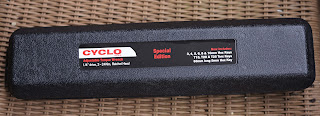No sooner had I tweaked Ursula’s Hollowtech II bottom bracket bearings, the rear XT hub came out in sympathy. I’d been bombing along the backroads and trails, getting some decent miles on the Maxxis Ikon...Came home, rested the bike down and felt some slop. Gripping the rear wheel between thumb and forefinger confirmed this.
Time was at a premium, so (before I started catastrophising and tearing everything down, replacing freehub bodies etc), the obvious thing to do was switch over to the Ryde Halo Spin Doctor combo, and then inspect the XT at a more convenient moment.
Wheel swap and cursory inspections complete, now was the time to tweak the fixed gear winter/trainer’s chain tension-the “oh well, might as well, since I’m here” mindset. Later inspection with a relatively calm mind confirmed it was just a matter of whipping out the 15mm cone and 17mm spanners and dialling everything snug.
Oodles of grease clinging to the balls and races, locking the elements out. In my experience, Juice Lubes Bearing Juice is particularly good for hubs as they’re always turning. I’ve found it temperature sensitive, so in common with Green Oil Eco Grease can congeal a little when the temperature’s tanking, meaning headset bearings can feel like they’ve too much preload. At the other extreme, it assumes a lower viscosity and buttery smooth when temperatures hit the mid-twenties. An observation, rather than a criticism.
Anyhow, the slop was easily corrected by loosening the locknut and snugging the cone tighter. Bearings were only replaced in April, races were good, and I double-checked the freehub, since I was about it. No obvious signs of wear there, either. I revisited things the next morning, tightened the cone fractionally, holding it in place while winding the locknut tight. Back went the cassette and lockring.
A final neurotic turn and tug of the bearings, job done. Anyhow, since I’d switched to the Halo Spin Dr, which is a lovely hub, I’ll leave the Ryde/Spin Doctor wheel in situ. Schwalbe are sending me their Smart Sam tyres for testing. It’ll be interesting to see how they compare with the Maxxis Ikon.
The Smart Sam are another cross-country tyre that’s been around a while and reckoned a competent all-rounder with decent rolling resistance on tarmac too, courtesy of the centre strip. Once upon a time, dual-purpose tyres were the worst of both worlds, ponderous on the road and toothless I the dirt. There’s obviously an element of compromise to be expected but they, like the Ikon, sound close to my particular mixed terrain niche.
Talking temperatures and seasons, the nights are just beginning to draw, dare I say, sneak in a bit now and my attention is turning to new season lighting. I’m very impressed by Ravemen and their TR200 Rear Light. It’s a six-mode, sensored model producing a maximum of 200lumens. Braking functions have been a thing for a good few years now and predictably, have come a long way. Now, “braking” is a debated term.
Accelerometer is probably closer to the mark as the internal sensor triggers the light when it identifies a drop in pace, or vibration. Earlier designs (c. 2017) were too sensitive and so triggered readily, which had a palpably negative effect upon battery life. This was particularly clear on sharp ascents, or when grinding along with a laden trailer en tow. I’ve noted tangible improvements in the past two years.
I’ve a soft spot for Ravemen CLO6 Sensored Rear Light RAVEMEN CL06 SENSORED REAR LIGHT | cycling-not-racing (sevendaycyclist.com) , BBB Signal Brake Rear Light, Magicshine See Mee 2000 Version2. Then of course, Ravemen TR500 USB Rechargeable Rear Light (500lumens) Ravemen TR500 Rear Light | cycling-not-racing (sevendaycyclist.com) which is in my view, particularly useful for trailers/tagalongs, tandems and other specialist builds.
Back to the TR200, it has three steady and three flashing modes. 40, 20 and 5 lumens and a 200-day flash, flanked by 100-lumen rapid and slow flashing modes. Interestingly, the “braking” function is 100, not the 200lumens and is triggered for two seconds when it senses a loss of tempo.
Run times on paper, seem favourable and there’s an auto kick down to the 5lumen steady, which is a welcome touch. The 260-degree lens with central convex and 4 LEDs bode well for presence and IPX6 should keep the elements at bay. Time and miles will tell...






















